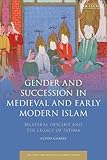Gender and succession in medieval and early modern Islam : bilateral descent and the legacy of Fatima / Alyssa Gabbay.
Material type: TextSeries: Early and medieval Islamic worldPublisher: London, England : Bloomsbury Publishing, [2020]Copyright date: ©2020Description: 1 online resource (xi, 262 pages) : illustrationsContent type:
TextSeries: Early and medieval Islamic worldPublisher: London, England : Bloomsbury Publishing, [2020]Copyright date: ©2020Description: 1 online resource (xi, 262 pages) : illustrationsContent type: - 9781838602345
- 1838602348
- 9781838602338
- 183860233X
- 9781838602321
- 1838602321
- 297.64 23
- BP80.F36 G335 2020eb
- online - EBSCO
| Item type | Current library | Call number | URL | Status | Notes | Barcode | |
|---|---|---|---|---|---|---|---|
 eBook
eBook
|
Biblioteca "Angelicum" Pont. Univ. S.Tommaso d'Aquino Nuvola online | online - EBSCO (Browse shelf(Opens below)) | Online access | Not for loan (Accesso limitato) | Accesso per gli utenti autorizzati / Access for authorized users | (ebsco)2365737 |
Includes bibliographical references.
Print version record and online resource (Bloomsbury, viewed April 16, 2024).
Intro -- Title Page -- Copyright Page -- Contents -- Illustrations -- Figures -- Tables -- Preface and acknowledgements -- Transliteration, periodization and dates -- Introduction: Redrawing family trees -- The problem of patrilineal descent -- Patrilineality versus bilateral descent, and a search for agency -- Defining Shi'ism -- Defining Fatima -- How this book is organized -- Part 1: Mothers -- Chapter 1: Umms and wombs: How and (maybe) why Shi'is reckoned descent through Fatima -- My mother, myself? -- Medieval views on generation -- Beyond biology -- How Fatima carried on her lineage
Umm Abīhā -- Challenges to bilateral descent -- Why was Fatima seen in this way? -- A closer look at Mary, Fatima and 'the family of 'Imran' -- Conclusion -- Chapter 2: Other mothers, other sons -- 'A better claim to the throne' -- Biographical dictionaries -- Shi'i hadith collections -- Historical chronicles -- Poetry and Sufism -- Legal texts -- Conclusion -- Part 2: Heiresses -- Chapter 3: Heiress to the Prophet: Fatima, Fadak and female inheritance -- Carving out a more prominent place for daughters -- The stark patrilineal model -- Inheritance and the advent of Islam
Inheritance in Sunni and Shi'i law -- The Fatima connection -- Fatima's khutba -- More Shi'i support for Fatima and Fadak -- Outside influences and Qur'an 8:75 -- Conclusion -- Chapter 4: Endowing agency: Daughters, waqfs and semi-matrilineal inheritance -- Deeds that speak -- Women and waqfs in pre-Safavid Iran and Central Asia -- 'Gunpowder' waqfs -- Sufi waqfs -- A matter of debate -- Conclusion -- Part 3: Successors -- Chapter 5: Speaking in her father's name: Fatima as successor to the Prophet Muhammad -- From mute to outspoken -- Female successorship in Islam
"In Gender and Succession in Medieval and Early Modern Islam: Bilateral Descent and the Legacy of Fatima, Alyssa Gabbay examines episodes in pre-modern Islamic history in which individuals or societies recognized descent from both men and women. Fatima, daughter of the Prophet Muhammad, features prominently in this study, for her example constituted a striking precedent for acknowledging bilateral descent in both Sunni and Shi'i societies, with all of its ramifications for female inheritance, succession and identity. Covering a broad geographical and chronological swath, Gender and Succession in Medieval and Early Modern Islam presents alternative perspectives to patriarchal narratives, and breaks new ground in its focus upon how people conceived of family structures and bloodlines. In so doing, it builds upon a tradition of studies seeking to dispel monolithic understandings of Islam and Gender."-- Provided by publisher.


